
Carpenter ants are large ants indigenous to many forested parts of the world.
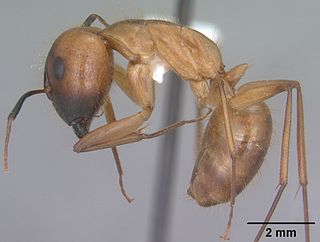
Camponotus festinatus is a species of carpenter ant that is typically found in the Southwestern United States and northern reaches of Mexico. It is most commonly found around Tucson, Arizona. It lives in the semi-dead branches of palo verde trees found in the area. Camponotus festinatus is an exclusively liquid feeder. These ants can only feed on sap from trees or the juices of a deceased animal. Like most ants, their diet is primarily sugar with some protein. Camponotus festinatus ants are not known to be aggressive except towards other ants. Soldiers will prefer to run from humans rather than be aggressive. In principle, these ants can bite with their mandibles. However, as carpenter ants like these are formicines, they have no functional sting. Instead of stinging, they can use an acidopore to spray formic acid.
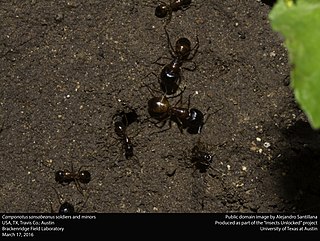
Camponotus sansabeanus is a species of carpenter ant native to the western United States, northern Mexico, Missouri, Arkansas, and Louisiana.
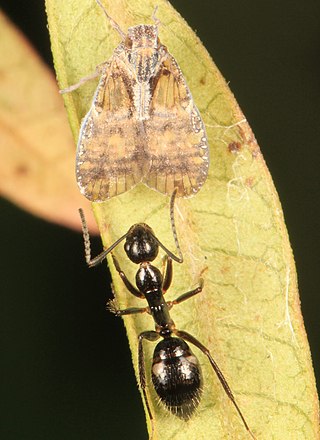
Camponotus sexguttatus is a species of carpenter ant native to South America, Central America, Mexico, and the Caribbean. This species is invasive in Florida, Hawaii, and Arizona.

Camponotus fragilis is a species of carpenter ant endemic to California, Texas, Arizona, New Mexico, and western Mexico. It was first described by Theodore Pergande in 1893, subsequently synonymized, then finally revived by Roy Snelling in 2006.

Camponotus mina is a species of carpenter ant native to large parts of northern Mexico, California, Arizona, Texas, and New Mexico, and possibly Wyoming, South Dakota, and Minnesota.

Camponotus vicinus is a species of carpenter ant widespread throughout western North America; it is found from Alaska, south to Mexico, and east to Texas and Manitoba. Unlike its wood-nesting relatives, C. vicinus is typically found nesting in the soil under stones and other objects.

Camponotus ocreatus is a species of carpenter ant native to northern Mexico and the southwestern United States.
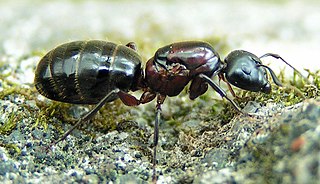
Camponotus novaeboracensis, the New York carpenter ant, is a species of carpenter ant native to the United States, Canada, possibly found in Costa Rica, Malaysia, and invasive in Bermuda.
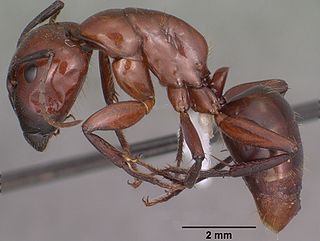
Camponotus schaefferi is a species of carpenter ant native to Arizona, New Mexico, and possibly Venezuela.
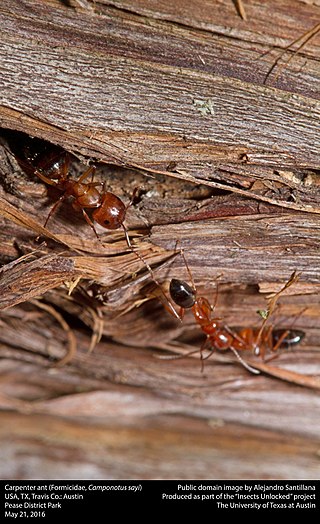
Camponotus sayi is a species of carpenter ant native to the southwest United States, northern Mexico, and possibly North Dakota, Ontario, Mississippi, North Carolina, South Carolina, and Florida.

Camponotus sericeiventris, the shimmering golden sugar ant, is a species of carpenter ant native to large parts of Central and South America.

Camponotus yogi is a species of carpenter ant native to California and Baja California.

Camponotus absquatulator is a species of carpenter ant native to California, Nevada, and Baja California. This species was separated from the Camponotus festinatus complex in 2006 by Roy Snelling.

Camponotus acutirostris is a species of carpenter ant native to Utah, Arizona, New Mexico, Texas, Chihuahua, and Baja California.

Camponotus fumidus is a species of carpenter ant native to Mexico, Arizona, Venezuela, and possibly Texas, New Mexico, the Bahamas, Jamaica, Hispaniola, and Chile.

Camponotus microps is a species of carpenter ant native to Arizona, New Mexico, Sonora, Queretaro, and Guanajuato. This species was separated from the Camponotus festinatus complex in 2006 by Roy Snelling.

Camponotus trepidulus is a species of carpenter ant native to Arizona, New Mexico, Baja California, Nayarit, Aguascalientes, and the State of Mexico.

Camponotus ulcerosus is a species of carpenter ant native to Mexico, Texas, New Mexico, and Arizona.

Camponotus vafer is a species of carpenter ant native to northern Mexico, Texas, New Mexico, Oklahoma, Arizona, and possibly Wyoming.




















